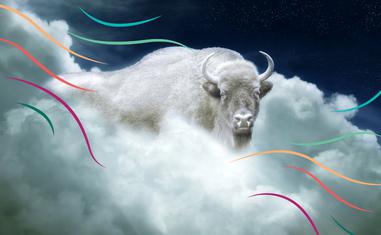The views expressed in our content reflect individual perspectives and do not represent the authoritative views of the Baha'i Faith.
In our continuing series of conversations on Indigenous beliefs between Lakota Baha’i Kevin Locke and Christopher Buck, this episode focuses on White Buffalo Calf Woman, the Lakota messenger of God.
Q: Kevin, in White Buffalo Maiden’s Sacred Songs, you told me about four sacred Lakota songs attributed to White Buffalo Calf Woman:
(Chris): Do the sacred songs traditionally said to have been given by White Buffalo Maiden enshrine Lakota spiritual teachings?
(Kevin): Yes. Even though the lyrics are terse, they are laden with layers of meaning. The songs don’t have names. But one can identify them by the context in which White Buffalo Maiden sang them:
1. Song of the White Buffalo Maiden
2. Pipe Loading Song
3. Prayer Song
4. Four Directions Song
I heard this ordering of the songs in the 1970s at a gathering of Medicine Men convened by Siŋté Glešká University held in St. Francis on the Rosebud Reservation. I have never heard this ordering repeated or affirmed by anyone else or at any other time. It should be emphasized that, although some may ascribe certain songs directly to White Buffalo Maiden (as in the above four songs), generally people agree that all of the “wakȟáŋ olówaŋ” (Sacred Songs) are inspired and reflective of the spiritual dispensation associated with the Maiden.
In White Buffalo Maiden: Sacred Rites, Dances, Songs, Values, you presented the lyrics of the first sacred song attributed to White Buffalo Calf Woman (also known as “White Buffalo Maiden”), in the original Lakota language, followed by an English translation:
Song of the White Buffalo Maiden
Niyáŋ tȟaŋíŋyaŋ with visible breath
mawáni ye I am walking
oyáte waŋ this nation (this Buffalo Nation)
imáwani I walk toward
na and
ho´tȟaŋíŋyaŋ my voice is heard
mawáni ye I am walking
niyáŋ tȟaŋíŋyaŋ with visible breath
mawáni ye I am walking
walúta waŋ this scarlet relic
awau we I am bringing
What are the spiritual teachings that White Buffalo Calf Woman imparts here? Is this White Buffalo Calf Woman’s declaration of her divine mission, along with the institution of her first sacred ritual involving the “scarlet” pipe?
A: As explained in Part 16 of our series, I first heard this song from Joseph Flying Bye, who, as a youth, had attended sun dances conducted by One Bull, the nephew of Sitting Bull.
My personal interpretation is that the Maiden here likens her message or dispensation to the onset of spring. “Breath” (niyan, or tȟaŋíŋyaŋ) more properly means “visibly, plainly, clearly, without concealment.” In this sense the “breath” indicates the divine holy waftings from the unseen realm, as is the Maiden’s voice (ho).The “visible” part is the effect of this heavenly wafting upon the collective heart of the “Buffalo Nation,” as the Lakota are also known, analogous to the transformation from winter into spring.
In fact, the “Buffalo Nation” is the original name of my people, because of their dependence upon the buffalo for physical sustenance. The Maiden made it known that the people no longer needed to depend upon the buffalo alone, but that “Grandfather” (the Great Spirit, or God) would provide. She named the people: “Lakȟóta.” This has been translated as “allies,” “friends,” “peace”— but really refers to compliance with the divine order or will.
“Walúta” is translated here as “scarlet relic.” It has also been translated as “something red, ancient and sacred.” It refers to the sacred pipe that the Maiden brought which, in turn, represents the covenant between White Buffalo Maiden and the Buffalo Nation and, more generally, the messenger of God, such as Baha’u’llah for this day and age, and the people for whom the messenger has come.
Q: Our readers may recall that you had previously presented this sacred prayer song, attributed to White Buffalo Calf Woman:
Pipe Loading Song
Kȟolá, léčhel ečhúŋ wo!
Kȟolá, léčhel ečhúŋ wo!
Kȟolá, léčhel ečhúŋ wo!
Héčhanuŋ kiŋ, nitȟúŋkašila
waŋníyaŋg ú kte ló.
Friend, do it in this way.
Friend, do it in this way.
Friend, do it in this way.
When (if) you do that, your Grandfather
will come to see you.
Hóčhoka waŋží ogná ílotake čiŋ,
míksuya opáǧi yo!
Héčhanuŋ kiŋ, táku ehé kiŋ,
iyéčhetu kte ló.
If you sit down inside the sacred circle/altar.
Remember me.
When you do that, then the things you say
will come true.
Čhaŋnúŋpa waŋží yuhá ílotake čiŋ,
míksuya opáǧi yo!
Héčhanuŋ kiŋ, táku yačhíŋ kiŋ,
iyéčhetu kte ló.
If you sit down with a pipe.
Remember me.
When you do that, then the things you want
will come true.
Kȟolá, léčhel ečhúŋ wo!
Kȟolá, léčhel ečhúŋ wo!
Kȟolá, léčhel ečhúŋ wo!
Héčhanuŋ kiŋ, nitȟúŋkašila
waŋníyaŋg ú kte ló.
Friend, do it in this way.
Friend, do it in this way.
Friend, do it in this way.
When (if) you do that, your Grandfather
will come to see you.
Can you tell us about this sacred Lakota prayer song?
A: As explained in Part 19, this song is a wonderful expression of the sacred teachings, laws and covenant articulated by the White Buffalo Maiden. These spiritual teachings transformed the people to the extent that White Buffalo Maiden renamed them. Formerly my ancestors called themselves “Pte Oyáte,” “Buffalo Nation,” or “Ikčé Oyáte,” “Common People.” White Buffalo Maiden renamed them “Lakȟóta” and commanded them to follow “Lakȟól Wičhóȟ’aŋ.” In other words, “the People of Peace” – not the peace that occurs because of the cessation of war, but the peace and order we observe in the natural world which is a manifestation of spiritual reality; the message that would enable humankind to reflect heavenly beauty, balance and harmony. In her song, White Buffalo Maiden exhorts the people to behave, act, and do things in this essentially sacred way.
Q: And now you are presenting White Buffalo Calf Woman’s “Prayer Song,” which is as follows:
Prayer Song
Wakȟáŋ Tȟáŋka tȟokáheya čhéwakiye.
Mitákuye ob waníkta čha tȟokáheya čhéwakiye.
First above all I pray to God.
That I may have life with my people I pray first above all.
Would you please comment on this song?
A: This song, attributed to White Buffalo Calf Woman, establishes the Lakota belief in one God, a central tenet of her dispensation. No matter what one’s inclination may be, in the final analysis, the source and object of all is one God. In the context of this prayer song, the text, “that I may have life with my people” refers to one’s eternal, spiritual life and how one’s destiny is interconnected with all of creation. In the White Buffalo Calf Woman’s teachings, “mitákuye”/“my relatives” refers to all of creation. For we are related to all under one God, as the following sacred song elaborates:
Four Directions Song
Wiyóȟpeyata étuŋwaŋ yo!
Nitȟúŋkašila ahítuŋwaŋ he yaŋké.
Čhékiya yo!
Čhékiya yo! Ahítuŋwaŋ he yaŋké.
Wazíyata
Wiyóhiyaŋpata
Itókaǧata
Look towards the West!
Your Grandfather is there looking towards you.
Pray! Pray!
He is looking towards you.
North . . .
East . . .
South . . .
In this sacred song, we are enjoined to turn to the four cardinal directions in expectant, longing devotion, anticipating attainment of the divine presence. It contains the promise that Grandfather – the Great Spirit, God – is ever-abiding and will assuredly respond. It carries the promise of reciprocity, that when one is sincere and turns to Grandfather, He will respond.
Q: Kevin, White Buffalo Calf Woman brought at least four sacred songs, seven sacred rites or ceremonies, and at least ten ethical teachings. Based on this legacy – and having yourself been raised with this Lakota spiritual worldview and within this social universe – how would you summarize and highlight the teachings and contributions of White Buffalo Calf Woman?
A: The name “Lakota,” given to us by White Buffalo Calf Woman, can mean many things, like people who have received the divine commandments or covenant, who are pious or faithful, and who are civilized. When the Lakota encountered Europeans, the Lakota thought them to be savage and barbaric in every way. The standard that the Lakota people used were the tenets brought by White Buffalo Calf Woman. Essentially she brought the laws and principles by which the Lakota people could be ennobled and civilized.
Q: Good point. Abdu’l-Baha also called Europe “morally uncivilized” in his book The Secret of Divine Civilization:
Be just: can this nominal [European] civilization, unsupported by a genuine civilization of character, bring about the peace and well-being of the people or win the good pleasure of God? Does it not, rather, connote the destruction of man’s estate and pull down the pillars of happiness and peace?
At the time of the Franco-Prussian War, in the year 1870 of the Christian era, it was reported that 600,000 men died, broken and beaten, on the field of battle. How many a home was torn out by the roots; how many a city, flourishing the night before, was toppled down by sunrise. How many a child was orphaned and abandoned, how many an old father and mother had to see their sons, the young fruit of their lives, twisting and dying in dust and blood. How many women were widowed, left without a helper or protector.
And then there were the libraries and magnificent buildings of France that went up in flames, and the military hospital, packed with sick and wounded men, that was set on fire and burned to the ground. And there followed the terrible events of the Commune, the savage acts, the ruin and horror when opposing factions fought and killed one another in the streets of Paris. There were the hatreds and hostilities between Catholic religious leaders and the German government. There was the civil strife and uproar, the bloodshed and havoc brought on between the partisans of the Republic and the Carlists in Spain.
Only too many such instances are available to demonstrate the fact that Europe is morally uncivilized.
Abdu’l-Baha’s critique of Western civilization, in this regard, could and certainly would extend to the European conquest and colonialization of the Americas.
Kevin, thank you for elucidating and illuminating the sacred, peaceful, civilized, and universal teachings of White Buffalo Calf Woman!


















Comments
Sign in or create an account
Continue with Facebookor